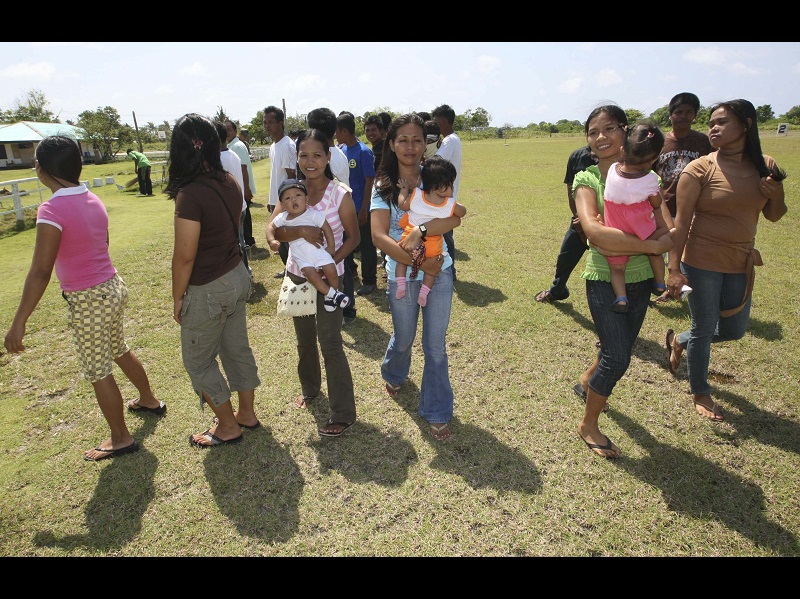On disputed Spratly isle, boredom is main concern

Filipino women carry their babies as they gather to welcome the arrival of Filipino lawmakers on Pag-asa Island, part of the disputed Spratly group of islands. AP
PAG-ASA ISLAND, West Philippine Sea—On this speck of a sun-splashed island in the turquoise West Philippine Sea, there is little sign of the tensions that have consumed politicians and diplomats in distant Asian capitals.
Six different nations are pressing their stake to all or part of these potentially oil- and gas-rich waters teeming with fish. Most recently, the Philippines and Vietnam have been wrangling with China in a noisy territorial dispute that is dominating this week’s Asian security forum in Bali.
And yet, here on Pag-asa, the only sounds are the waves slapping the shore and the wind whistling in the ears. At high noon, fighting off sleep is a struggle.
There are no cars, newspapers, Internet connections or shopping malls on an island that mostly consists of a single gravel airstrip and some structures. This, one of the nine islands, reefs and shoals occupied by Philippine troops, is also claimed by China, whose looming presence and rising military power is a worry for outgunned neighbors.
Two Filipino police officers, looking bored, say there hasn’t been a single crime for years.
“One big problem really is how to kill time,” said Mayor Eugenio Bito-onon Jr. of Kalayaan town, which includes far-flung Pag-asa.
“After fishing, walking around, playing billiards and cards, what else can one do next?” wondered the bespectacled mayor.
The tadpole-shaped, 37-hectare (91-acre) Pag-asa, or ‘hope’ in the Tagalog language, is the biggest of the Philippine-held islands in the West Philippine Sea’s Spratlys archipelago. Taiwan, Brunei, Malaysia and Vietnam also claim the islands.
The battle for ownership has settled into an uneasy standoff since the last fighting, involving China and Vietnam, killed more than 70 Vietnamese sailors in 1988.
Tensions flared again this year after the Philippines and Vietnam separately accused China of encroaching into their territorial waters, sabotaging oil exploration and harassing fishermen. China, which claims the entire West Philippine Sea on historical grounds, acknowledges some of the incidents in what it says are its waters, and Beijing has warned other claimants to stop exploring for oil and gas without its permission.
The incidents, accusations and feelings of hurt of national pride carried over to Bali and this week’s meeting of the 10-member Association of Southeast Asian Nations. On Wednesday, China announced it was ready to firm up existing nonbinding guidelines for behavior in the contested waters.
Philippine Foreign Secretary Albert del Rosario balked, saying the guidelines have no teeth and that his country plans to take China to a UN tribunal that handles maritime border disputes.
And at the opening of Vietnam’s National Assembly on Thursday, Deputy Prime Minister Nguyen Sinh Hung talked tough too, saying Hanoi will “resolutely and comprehensively … implement measures to defend the country’s sovereignty, protect fishermen, economic and trade activities and protect oil and gas exploration and exploitation activities under its sovereign seas.”
Washington says it is ready to play a role to peacefully resolve the row, but China has warned the US to stay away.
On Pag-asa, where about few dozen people live since the Philippine government lured civilians starting in 1978 with free food and other incentives, the worrisome rhetoric has reached through news from satellite TV or by cellphones—although the signal is often cut by bad weather, poor infrastructure or unpaid bills.
It takes days to reach Pag-asa by boat across often-turbulent waters from the nearest Philippine municipality in Palawan province, about 300 miles (480 kilometers) to the east.
One family fled in fear last month but the rest stayed on.
A longtime resident, Obnor Lenasic, said the news does not bother villagers. He said nationals from rival claimants have learned to live together in the disputed region. They wave at each other when their fishing boats cross at sea. Filipinos sometimes barter coconut for Chinese cigarettes, he said.
In the past, Chinese and Vietnamese forces would fire warning shots in the air when others get near their islands. Filipinos would raise fish on skewers to signal that they were just fishing. The soldiers would smile and spread their palm to beg for some of the catch, Bito-onon said.
Another resident, Aisa Bilidan, said she named her baby daughter born on Pag-asa last March China-lyn, after the Philippines accused Beijing of being a bully.
Except for a few rusting anti-aircraft guns, their turrets capped by plastic to avoid damage from the salty air, and the presence of troops, Pag-asa resembles a typical Philippine rural village — serene and backward.
Four Filipino lawmakers Wednesday defied protests from the Chinese Embassy in Manila and flew to the island, carrying with them two new Philippine flags to replace a tattered one flapping in the breeze.
The lawmakers asked the villagers about their concerns but nobody mentioned the Spratlys dispute. One wanted a better grass-cutter to clear a nearby airstrip of weeds. Another sought a Jeep to move things around the community and a soldier appealed for help in repairing a desalinating machine for drinking water.
Bito-onon told the lawmakers that turning Pag-asa into a bustling civilian community, with sustainable livelihood in fishing and tourism, would be the strongest argument for the Philippine territorial claim.
He told The Associated Press on Thursday that he was working on a solution to lure more people and tourists to the remote island: an Internet connection, which he hopes to set up with government help in the near future.
“I think it will help if people know that after a nice swim on the island, they can take a break and connect to their Facebook accounts,” Bito-onon said. “I have a feeling that that will work.”














